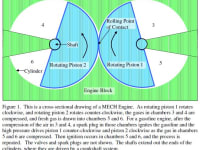
About one-third of the fuel used in the world is for internal combustion engines in cars and trucks. Given the combustion temperatures in these engines, the theoretical efficiency is over 70%, but the efficiency of present-day car engines is about 25%. A large part of the energy loss is due to sliding friction of the pistons in the cylinders. It is well known that sliding friction can be a hundred times as great as rolling friction. If the sliding friction of pistons could be replaced by rolling friction, much higher efficiency engines could be produced.
We have patented a revolutionary new engine called “MECH” that substitutes rolling friction for sliding friction in internal combustion engines. “MECH” stands for Motor, Expander, Compressor, and Hydraulics, since it can be adapted to internal combustion engines, gas expanders, compressors, or hydraulic pumps or hydraulic motors. Besides having less friction, the MECH engine’s novel geometry provides three times the displacement (and hence three times the power) of a standard car engine of the same size. Or a MECH engine of the same power would be one-third the size. By having a lighter, more efficient engine, energy is conserved.
Figure 1 shows a simplified cross section of MECH. Rotating piston 1 rolls against rotating piston 2 at the point of contact, forming a rolling seal that prevents gases from flowing from high to low pressure regions. When rotating piston 1 rotates clockwise and rotating piston 2 rotates counter-clockwise, fuel-air mixtures in chambers 3 and 4 are compressed. A spark ignites the mixture, and the resulting explosion causes the pistons to rotate in the opposite directions, compressing fuel-air mixtures in chambers 5 and 6. Combustion in those chambers reverses the directions of the rotating pistons.
The pistons do not touch the cylinder walls. Sliding friction occurs at the ends of the pistons where special seals are installed, but since the pistons can be long compared to the diameter, this friction is small. The shafts exit through the end plates where they are connected to gearwheels that rotate together. A crank rod connects one of the gearwheels to a flywheel.
MECH can have more than two pistons in the block.
It is projected that MECH efficiency will be 30% higher than a standard engine. The fact that it is lighter and smaller will allow a lighter-weight car, which will also increase gas mileage. A MECH expander, which we built (see Figure 2), was tested and compared to a regular piston expander of the same displacement. 13 psi of air pressure was required to keep the regular piston expander running. Below that pressure, friction caused the engine to stop running. A scroll compressor of the same size required 8 psi to keep it running. The MECH expander required only 1 psi to keep it running.
Figure 3 provides a perspective view of MECH.
The market for MECH as internal combustion engines and air-conditioning compressors is huge. MECH can also be used in chain saws and lawn mowers.
-
Awards
-
 2012 Top 100 Entries
2012 Top 100 Entries
Like this entry?
-
About the Entrant
- Name:Melvin Prueitt
- Type of entry:individual
- Software used for this entry:My own computer programs.
- Patent status:patented








